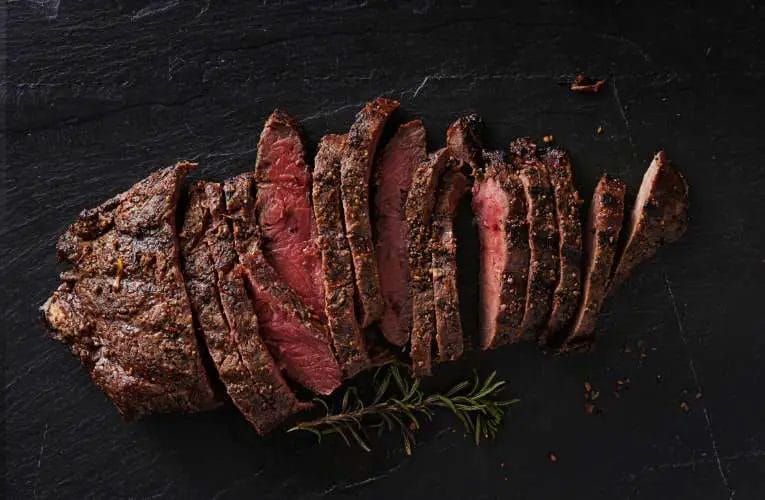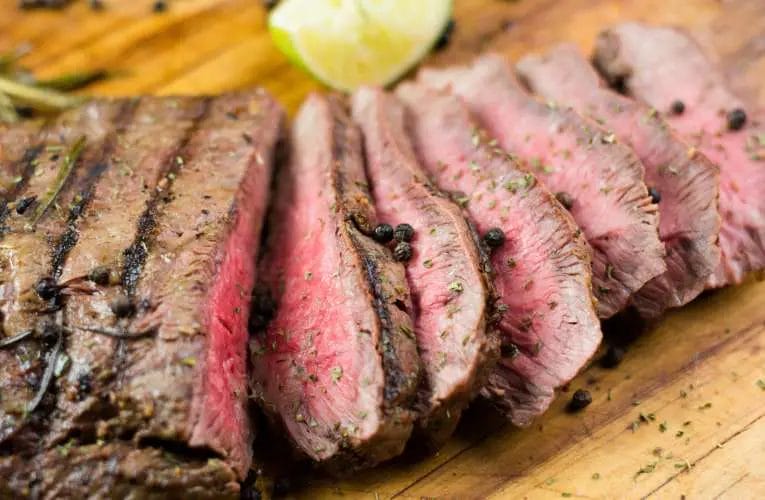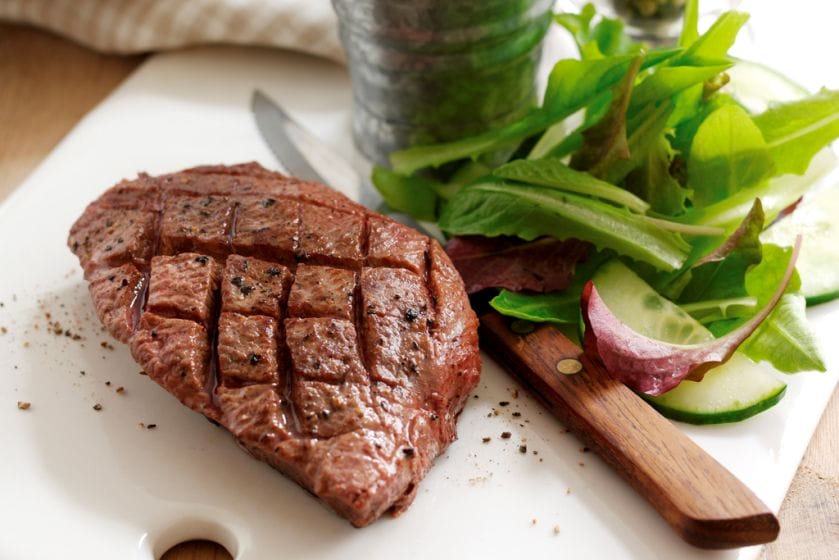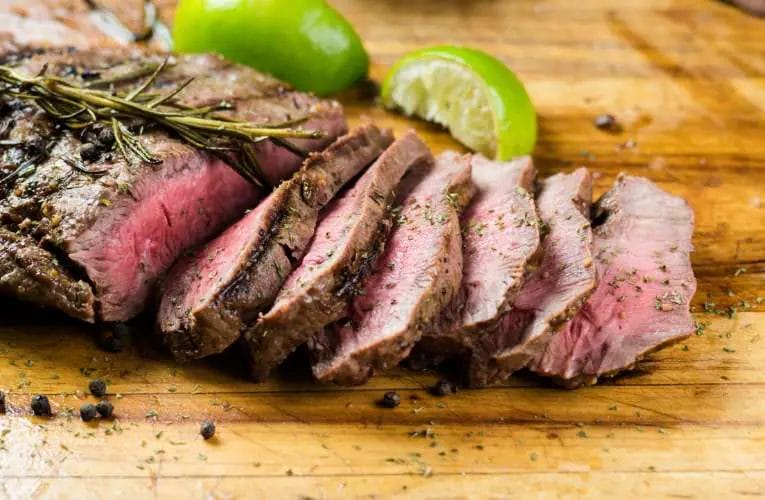Are you wondering if flat iron steak is a healthy choice? Look no further! In this article, we will explore the nutritional benefits of flat iron steak and how it can fit into a balanced diet.
Packed with essential nutrients like protein, iron, and vitamin B12, flat iron steak can be a nutritious option for meat lovers. Additionally, its low fat content makes it a healthier alternative to other cuts of beef.
Discover the potential health benefits of including flat iron steak in your diet and how to prepare it for a delicious and wholesome meal.

Health Benefits of Flat Iron Steak
When it comes to enjoying a delicious and satisfying steak, the flat iron steak is a popular choice for many meat lovers. Not only does it offer a rich and succulent flavor, but it also comes with a range of health benefits that make it a nutritious addition to your diet.
In this section, we will explore some of the key health benefits of flat iron steak.
1. High in Protein
One of the main health benefits of flat iron steak is its high protein content. Protein is an essential nutrient that plays a crucial role in building and repairing tissues in the body.
Consuming an adequate amount of protein is not only important for muscle growth and maintenance, but it also helps to keep you feeling full and satisfied for longer periods of time, which can aid in weight management.
2. Rich in Iron
Flat iron steak is a great source of iron, which is an essential mineral that is responsible for carrying oxygen throughout the body and producing energy.
Iron plays a vital role in the production of red blood cells and helps prevent iron-deficiency anemia. Including flat iron steak in your diet can help boost your iron levels and promote overall health and well-being.
3. Packed with B Vitamins
Flat iron steak is also rich in various B vitamins, including B12, B6, and niacin. These vitamins are important for maintaining healthy nerve function, supporting brain health, and aiding in the production of red blood cells.
B vitamins are also known to play a role in metabolism, helping the body convert food into energy.
4. Contains Essential Minerals
In addition to iron, flat iron steak is a good source of other essential minerals such as zinc and selenium. Zinc is important for immune function, wound healing, and cell division, while selenium acts as a powerful antioxidant and supports thyroid function.
5. Low in Calories
If you’re watching your calorie intake, you’ll be glad to know that flat iron steak is relatively low in calories compared to other cuts of beef. This makes it a suitable option for those who are looking to maintain or lose weight while still enjoying a flavorful and satisfying meal.
6. High in Omega-3 Fatty Acids
Another health benefit of flat iron steak is its relatively high omega-3 fatty acid content. Omega-3 fatty acids are essential fats that are known for their anti-inflammatory properties and their role in promoting heart health.
Including flat iron steak in your diet as part of a balanced meal plan can contribute to your omega-3 intake.
7. Source of Essential Amino Acids
Flat iron steak contains all nine essential amino acids, which are the building blocks of proteins. These amino acids cannot be produced by the body and must be obtained through the diet. Consuming flat iron steak helps ensure that your body gets an adequate supply of these vital nutrients.

Nutritional Value of Flat Iron Steak
Flat Iron Steak, also known as Top Blade Steak, is a popular cut of beef that is tender, flavorful, and versatile. It is derived from the shoulder of the cow and has become increasingly popular due to its rich marbling and delicious taste.
Not only does it satisfy your taste buds, but it also offers several nutritional benefits that make it a healthy choice for meat lovers.
Protein
One of the major nutritional benefits of flat iron steak is its high protein content. Protein is an essential nutrient that plays a vital role in building and repairing tissues, supporting muscle growth, and maintaining a healthy immune system.
A 3-ounce serving of flat iron steak provides approximately 26 grams of protein, making it an excellent choice for individuals looking to increase their protein intake.
Vitamins and Minerals
Flat iron steak is also a good source of various vitamins and minerals that are essential for overall health and wellbeing. It contains significant amounts of vitamins B6 and B12, which play a crucial role in brain function, energy production, and the formation of red blood cells.
Additionally, it is a rich source of iron, zinc, and selenium, which are important for maintaining healthy blood cells, supporting immune function, and promoting proper growth and development.
Fat Content
While flat iron steak is relatively lean compared to other cuts of beef, it still contains a moderate amount of fat. However, the type of fat found in flat iron steak is mostly monounsaturated and polyunsaturated fats, which are considered heart-healthy fats.
These fats can help reduce bad cholesterol levels and lower the risk of heart disease when consumed in moderation.
Calories
The calorie content of flat iron steak can vary depending on the cooking method and any additional ingredients used. On average, a 3-ounce serving of flat iron steak contains around 180-220 calories.
It’s important to note that the calories primarily come from protein and fat, so portion control is necessary if you are watching your calorie intake.
Preparation Tips
When preparing flat iron steak, it is recommended to trim any visible fat to reduce the overall fat content. Marinating the steak before cooking can add flavor and tenderness while keeping the meat moist.
Grilling, broiling, or pan-searing are popular cooking methods that can help retain the nutritional value and enhance the taste of flat iron steak.
How to Incorporate Flat Iron Steak into a Healthy Diet
Flat iron steak, also known as top blade steak, is a flavorful and tender cut of beef that can be a delicious addition to a healthy diet.
While red meat has often been associated with negative health effects, when consumed in moderation and as part of a balanced diet, flat iron steak can provide essential nutrients and contribute to overall health.
Here are some tips on how to incorporate flat iron steak into a healthy diet:
1. Choose Lean Cuts
When selecting flat iron steak, opt for lean cuts to minimize the saturated fat content. Look for cuts with minimal visible marbling and trim off any excess fat before cooking.
Choosing lean cuts will help reduce the calorie and fat intake while still enjoying the flavor and benefits of flat iron steak.
2. Control Portion Sizes
Portion control is key when incorporating any type of meat into a healthy diet. Keep in mind that a healthy portion of flat iron steak is about 3-4 ounces, which is roughly the size of a deck of cards.
By controlling portion sizes, you can enjoy the taste of flat iron steak without consuming excessive calories or fat.
3. Pair with Fresh Vegetables
To make your flat iron steak meal even healthier, pair it with a variety of fresh vegetables. Vegetables are rich in vitamins, minerals, and fiber, and they can complement the protein content of the steak.
Consider grilling or roasting vegetables like asparagus, bell peppers, zucchini, or mushrooms to create a well-rounded and nutritious meal.
4. Use Healthy Cooking Methods
The way you cook your flat iron steak can greatly impact its nutritional value. Opt for healthier cooking methods such as grilling, broiling, or baking instead of frying or sautéing in oil.
These methods help to preserve the natural flavors of the steak without adding unnecessary calories or unhealthy fats.
5. Limit Sodium and Seasoning
To maintain a healthy diet, it’s important to limit the amount of sodium and seasoning you add to your flat iron steak.
Excessive sodium intake can lead to high blood pressure and other health issues. Instead, try using herbs, spices, and marinades with minimal sodium content to enhance the flavor and enjoy a healthier meal.
6. Include in Balanced Meals
Incorporating flat iron steak into a balanced meal is essential for maintaining a healthy diet. Pair it with whole grains like quinoa or brown rice and add a side of leafy greens or a colorful salad to create a well-rounded plate.
This combination ensures you’re getting a variety of nutrients and helps to balance the protein, carbohydrates, and fats in your meal.
7. Practice Moderation
While flat iron steak can be a healthy addition to your diet, it’s important to practice moderation. Enjoy flat iron steak as part of a varied diet that includes other lean proteins, fruits, vegetables, and whole grains. Remember, balance and moderation are key to maintaining a healthy lifestyle.

Tips for Cooking a Healthy Flat Iron Steak
Flat iron steak is a tender and flavorful cut of beef that can be a delicious and healthy option for your meals. Whether you’re a seasoned cook or a beginner in the kitchen, here are some tips to help you cook a healthy flat iron steak:
1. Choose a lean cut
When buying a flat iron steak, look for a lean cut with minimal marbling. This will help reduce the amount of saturated fat in your dish. Opt for grass-fed beef if possible, as it tends to have a higher omega-3 fatty acid content.
2. Trim excess fat
Prior to cooking, trim any excess fat from the flat iron steak. This will further reduce the fat content and contribute to a healthier meal. Use a sharp knife to carefully remove any visible fat along the edges of the steak.
3. Marinate for flavor
Marinating the flat iron steak can enhance its flavor and tenderize the meat. Choose a marinade that is low in sodium and contains healthy ingredients such as olive oil, citrus juices, herbs, and spices. Avoid store-bought marinades that are high in added sugars or unhealthy additives.
4. Use healthy cooking methods
When it comes to cooking your flat iron steak, opt for healthier methods such as grilling, broiling, or pan-searing. These methods require minimal added fats and can help retain the natural flavors of the meat. Avoid deep-frying or breading the steak, as these can add unnecessary calories and unhealthy fats.
5. Cook to the right temperature
Properly cooking the flat iron steak to the right temperature is essential for both safety and taste. Use a meat thermometer to ensure the steak reaches the recommended internal temperature of 145°F (63°C) for medium-rare. Overcooking the steak can result in a tougher texture and loss of flavor.
6. Rest before slicing
After cooking the flat iron steak, allow it to rest for a few minutes before slicing. This resting period allows the juices to redistribute throughout the meat, resulting in a juicier and more tender steak. Use a sharp knife to slice the steak against the grain for maximum tenderness.
7. Pair with healthy sides
Complete your healthy flat iron steak meal by pairing it with nutritious sides. Opt for roasted vegetables, steamed greens, or a fresh salad to add vitamins, minerals, and fiber to your plate. Avoid heavy and calorie-dense sides such as creamy mashed potatoes or fried foods.
8. Practice portion control
While flat iron steak can be a healthy choice, it’s important to practice portion control. Aim for a recommended serving size of 3 to 4 ounces of cooked steak. This will help you maintain a balanced meal and prevent excessive calorie intake.
By following these tips, you can cook a healthy and delicious flat iron steak that you can enjoy guilt-free. Experiment with different flavors and cooking methods to find your favorite way to prepare this versatile cut of beef.

Comparison of the Healthiness of Flat Iron Steak with Other Cuts of Beef
When it comes to choosing a cut of beef, health-conscious individuals often weigh the nutritional benefits and potential risks associated with each option. Flat iron steak, known for its tenderness and flavor, has gained popularity in recent years.
In this section, we will compare the healthiness of flat iron steak with other cuts of beef, shedding light on their nutritional profiles and potential health implications.
1. Nutritional Composition
Flat iron steak is a lean cut of beef that offers a range of essential nutrients. It is a rich source of high-quality protein, which is vital for muscle growth, repair, and overall health.
Additionally, flat iron steak contains significant amounts of several essential vitamins and minerals, including iron, zinc, and B vitamins. These nutrients play key roles in energy metabolism, immune function, and red blood cell production.
When compared to other cuts of beef, flat iron steak stands out for its lower fat content. It is relatively low in saturated fat, which is known to raise cholesterol levels and increase the risk of heart disease.
In fact, flat iron steak contains less fat than cuts like ribeye or T-bone steak, making it a healthier choice for individuals looking to maintain a balanced diet.
2. Cholesterol Levels
Cholesterol levels in beef can vary depending on the cut and the animal’s diet. Consuming large amounts of cholesterol-rich foods may contribute to high blood cholesterol levels, which can increase the risk of heart disease.
In this context, it is worth noting that flat iron steak has a lower cholesterol content compared to fattier cuts like ribeye or porterhouse steak.
However, it is important to remember that the cholesterol content in food does not have as significant an impact on blood cholesterol levels as was once believed. The body’s own production of cholesterol plays a more significant role in determining blood cholesterol levels.
3. Omega-3 Fatty Acids
Omega-3 fatty acids, known for their heart-healthy benefits, are predominantly found in fatty fish. While beef is not as rich in omega-3s as seafood, some cuts do contain small amounts.
Unfortunately, flat iron steak is not particularly high in omega-3 fatty acids compared to other cuts like salmon or mackerel. If you are specifically looking to increase your omega-3 intake, other protein sources may be more suitable.
4. Preparation and Cooking Methods
The healthiness of any cut of beef also depends on how it is prepared and cooked. Choosing healthier cooking methods, such as grilling, baking, or broiling, can help minimize the addition of excess fats and calories.
Avoiding heavy sauces or marinades high in added sugars and sodium can further enhance the healthiness of the dish.
Additionally, it is important to consider portion sizes when consuming beef. Moderation is key, as excessive consumption of any type of meat can have potential health risks. Balancing your plate with plenty of vegetables and whole grains can help create a well-rounded and nutritious meal.

FAQs
Is flat iron steak healthy?
Flat iron steak can be a part of a healthy diet. It is a lean cut of beef that is high in protein and contains essential nutrients like iron and zinc. However, it is important to consider portion sizes and cooking methods to maintain a balanced and healthy diet.
Conclusion
In conclusion, the flat iron steak is a delicious and versatile cut of meat that can be enjoyed as part of a healthy diet. While it is important to consume in moderation, the flat iron steak is a good source of protein, vitamins, and minerals.
Its lean and tender nature makes it a popular choice among health-conscious individuals. By pairing the flat iron steak with a balanced selection of vegetables and whole grains, you can create a nutritious and satisfying meal.
Remember to prepare it using healthy cooking methods, such as grilling or broiling, to minimize added fats and oils. Enjoy the flat iron steak as a flavorful addition to your healthy lifestyle.

